How To Cook Fish in a Pan
-
Darrian Wilkins
- Last update: November 5, 2021
Disclaimer: we may receive commissions from purchases made via our links at no cost to you
Cooking fish is a daunting task for the unfamiliar home cook. Cooked wrong, fish can become dry, fishy, flavorless, and can fall apart quickly.
Cooking delicious fish is simple and fast, follow the following tips and cooking techniques, and it will turn out perfect every time.
Pan-cooking fish is one of the best ways to cook fish. Fish can be cooked using several different ways, including, seared, shallow fried, grilled, or poached.
However, despite the cooking method, there are a few simple tips to follow that will set you well on your way to being a master fish cook, before even lifting a pan.
Know your Fish

When cooking fish it helps to know what types of fish are better for certain preparations. Fish that have a high concentration of fat in their meat like salmon are great for pan-searing. Whereas white-fleshed swordfish is a firm fish that cooks welled when cooked on a grill pan. And a beautiful whole trout poached in white wine is just divine.
What To Look for When Buying Fresh Fish
The first thing to check for fish freshness is the smell. Fresh fish will have a clean, briny fresh ocean breeze smell. If your fish has an odor that is “fishy” the fish is not fresh.
Buying whole fish is cheaper than buying fillets or steaks. When buying a whole fish always check the eyes. The eyes should be bright, shiny, and full. Sunken or cloudy eyes are a sure sign the fish is not fresh. The skin and scales should be bright and metallic in appearance, dull or shrunken skin is a sign of old fish. And avoid fish that is soft or squishy when touched. The flesh of the fish when pressed down on should be firm and springing. And lastly, check for the color of the fish’s gills, they should be bright red and clean.
If you are buying fish fillets or fish steaks from your fishmonger, things to check include, making sure the flesh is firm and bright. Make sure the grain of the fish flesh is smooth and intact and ensure that it smells clean. Dull or soft fish flesh, flaky structured, and slimy fish fillets are a sign the fish is old and not fresh.
Techniques For Fish Preparation
Whole fresh fish is prepared in four stages: scaling, trimming, gutting and, (if required) filleting. Now you can ask your fishmonger to perform these tasks for you when buying your fresh fish, but it is cheaper and more educational for home cooks to process their own fish. However, as we are discussing how to cook fish in a pan, we will not delve into this in-depth, just be aware that this is an important process before cooking your fish.
If you are cooking with frozen fish, take it out of the freezer and let it thaw in the fridge. This will keep it fresh and prevent it from spoiling. Placing your frozen fish in the fridge in the morning will allow enough time for it to thaw by the evening. Always wash frozen fish under water to remove any scales or residue remaining from processing, and pat dry using a paper towel.
Choice of Pan
There are many different materials used to make pans. But to cook fish, a heavy-duty skillet with a diameter of 12 -14 inches, which is made from either stainless steel, cast iron, or has a nonstick surface is an ideal pan to use. However, there are just a few things to remember when selecting your pan.
When selecting a Stainless Steel skillet choose a 3 or 5 Ply construction. These heavy-based pans are the ideal pan to sear, shallow fry, or poach fish fillets or whole fish. As they even distribute heat evenly and can be heated to high temperatures required for these styles of cooking. As for poaching, stainless steel is inert and will not react to acids, which is perfect for many acidic liquids used for poaching.
Well-seasoned heavy-based cast-iron skillets are also suitable for searing, and shallow frying fish, but it is good to remember that cast iron tends to absorb the flavors and smell of the food being cooked in them. So, it is advised that you should properly clean and season your pan after cooking fish in them, to prevent your next meal from being tainted by the odor or taste of fish.
And only use a heavy nonstick frying pan. Using a thinly constructed nonstick pan will cause the fish to be in closer and harsher contact with the stove, causing the fish to brown unevenly in the few minutes it’s on the stove. Some crispy patches, some not so crispy ones.
Another great choice for a pan can be a cast iron or stainless steel grill pan. The grilled pattern of these pans is a perfect way to recreate a barbequed grilled pattern on fish fillets or whole fish.
Best Tool To Use When Cooking Fish
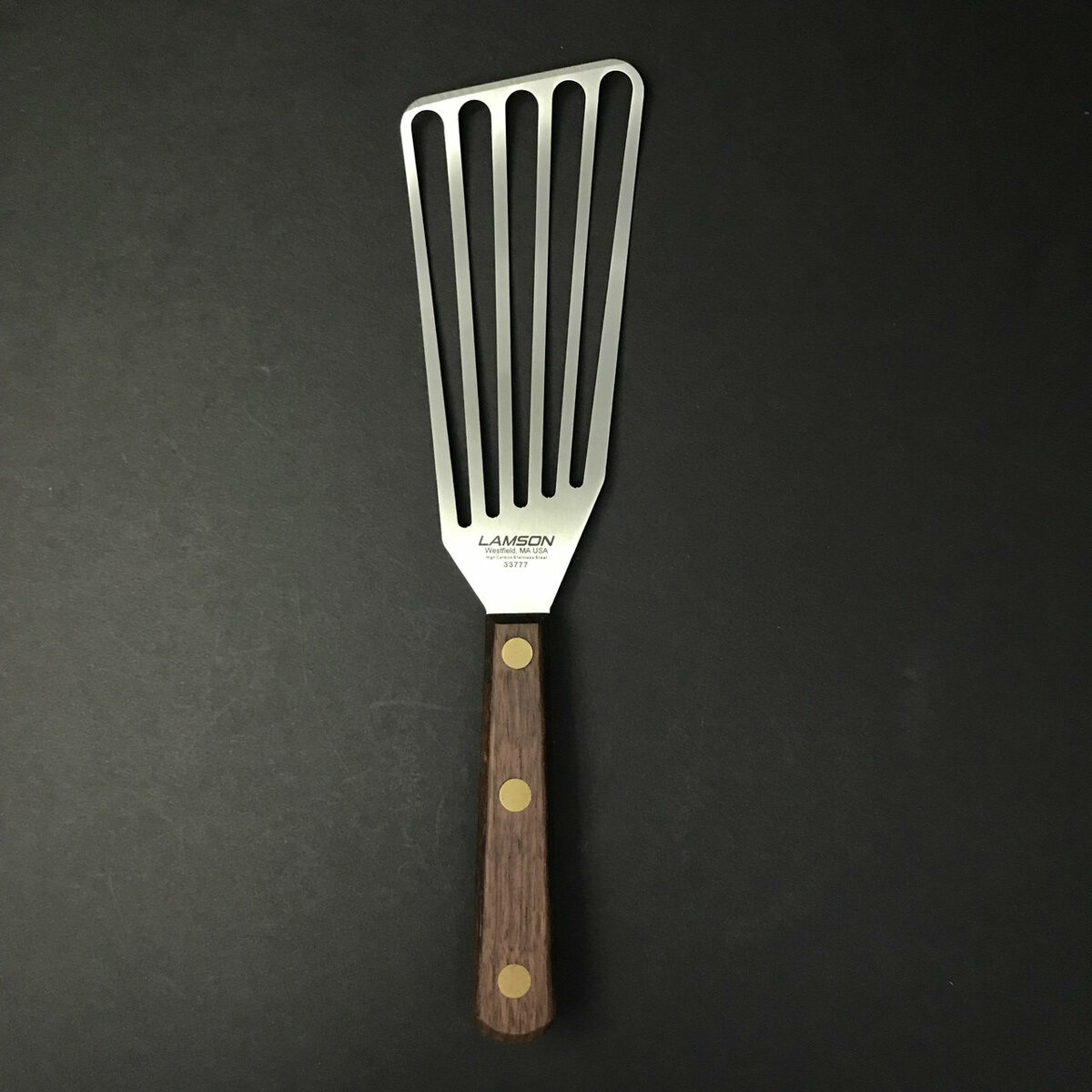
A fish spatula is your best friend when cooking fish in a skillet. The fish spatula has a much longer beveled-edged head and is an elongated and thinner version of the common metal spatula, It has a thin, almost-sharp edge, which makes it great for sliding under the delicate flesh of fish.
The long slots along the length of the face of the spatula allow the liquid of a poached or fried fish to easily drain away when handling the fish, especially when you turn and remove the fish from the pan.
Most common fish spatulas have hard long wooden handles, which provides great dexterity when turning fish and feels great in the hand when cooking for long periods.
Choosing a Cooking Method
It is important to understand your fish before selecting a cooking method. Some fish are more suited to certain types of cooking methods than others. Thoughts to consider when choosing a cooking method include the size or thickness of the fish, the natural flavor of the fish, the level of fat in the meat, the choice to remove the skin or to keep the fish whole.
Poached –
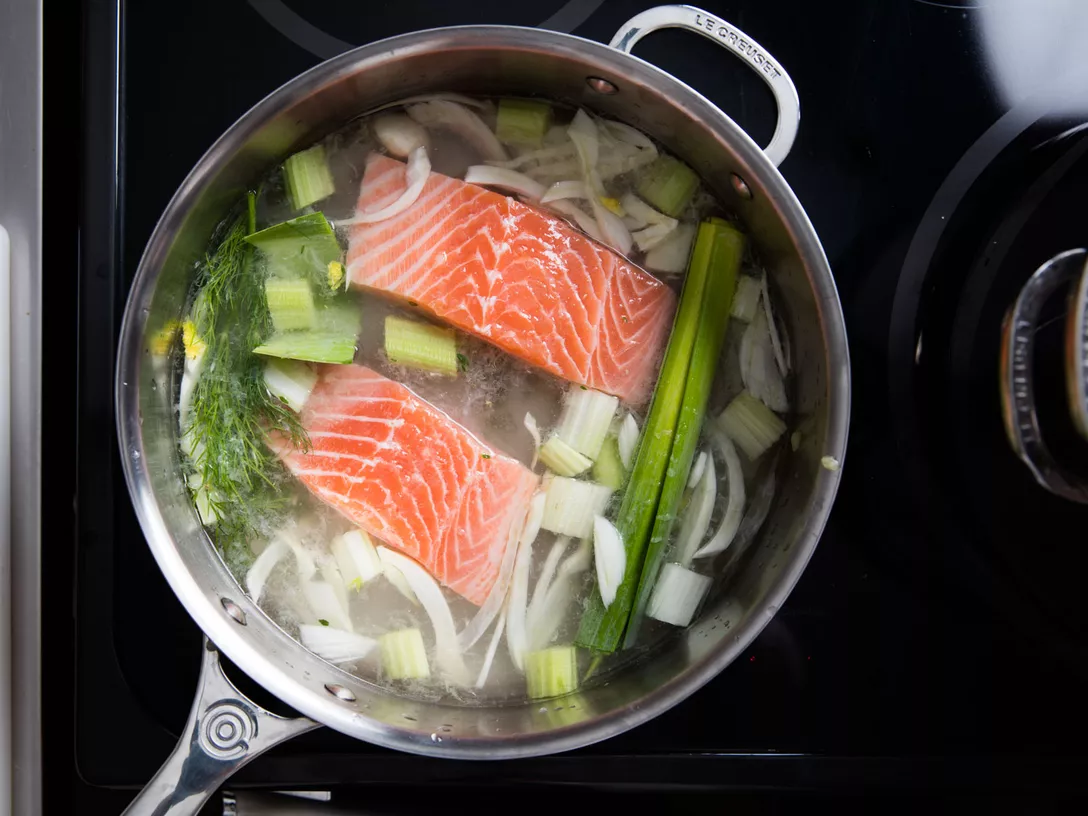
Poached fish is a technique that involves cooking by submerging fish in a liquid set at a low temperature between 55-65 C. Poaching preserves moisture and adds flavor without adding fat, and is a healthy alternative to frying.
As for the poaching liquid for fish, you can prepare liquids such as Wine, Court Bouillon, Beurre Monté, Olive Oil, or Coconut milk.
Some great fish species that are suited for poaching include Mahi Mahi, Barramundi, Sole, Salmon, Trout, and Sturgeon. Smaller fish species can be poached whole and fish fillets are perfect for this cooking method.
Method for poaching fish –
Thoroughly rinse the fish and pat dry with paper towels. Place fish in a stainless steel skillet and add enough poaching liquid to the pan to cover the fish.
Place skillet over low heat and increase the temperature to 65 degrees Celsius. Use a digital thermometer to ensure that temperature remains at a constant 65 degrees
Fish will be cooked once it reaches an internal temperature of 63 degrees Celsius, again test with a digital thermometer.
Once the fish has cooked, remove it from the liquid with a fish spatula and serve poached fish with a sauce to suit the poaching liquid.
Searing –
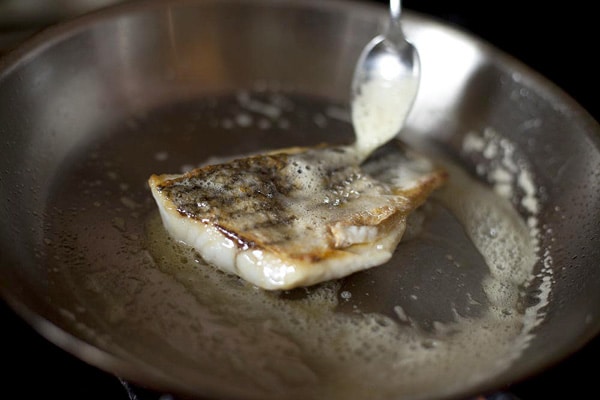
Pan-seared fish, crispy and golden on the outside and beautifully moist on the inside with or without skin, is one of the best cooking methods for fish. You can cook whole fish, fish steaks, or filleted fish for this cooking method.
Many different fish suit this cooking method. However, fish with many bones, very small fish, or very thin fillets are not recommended for searing.
Method For Searing Fish Fillets with skin on –
Remove fish from refrigerator 15 -20 minutes before cooking
Wash the fish fillet, then pat the fish dry with paper towels.
Using a sharp chef’s knife, gently scrape the blade across the fish skin. Any remaining liquid will collect on the blade edge. Remove the moisture from the blade and repeat until there is no more moisture on the knife blade.
Season both sides of the fish fillet with salt and black pepper.
Place a heavy stainless steel skillet over medium-high heat until it becomes very hot but it is not smoking.
Once the skillet reaches temperature (approximately 3 minutes), carefully add just enough high temperature, neutral-flavored, low cholesterol oil, like canola oil, to evenly coat the skillet.
Wait a few seconds for the oil to heat and then quickly add the fish, skin side down.
Fish with its skin on will contract and curl when it is added to the pan. The degree of curling is related to the freshness of the fish. The fresher it is, the more it will start to curl upwards. Once the fish begins to curl, take your fish spatula and press down on the entire fillet this will flatten the fillet, ensure even cooking and the skin will become crisp.
Adjust the heat to medium heat so as not to burn the fish.
Do not adjust or move the fish until golden brown color forms on the edge of the fish skin and the edges of the fish flesh become opaque, this should take 3 to 4 minutes. Once the skin has become crisp the fish fillet will naturally release once the surface is cooked and golden.
Carefully and gently carefully slide your fish spatula under the fish and lift the fillet and flip the fillet to cook on the other side. Add a tablespoon of butter and baste the fish until cooked through, this should only take 2 to 3 minutes longer, or test fish fillet with a digital thermometer ensuring it has reached an internal temperature of 63 degrees Celsius.
Gently remove the fish from the pan using a fish spatula, and transfer the cooked fish to a plate and serve with a squeeze of lemon, and season to taste.
Grilled Fish
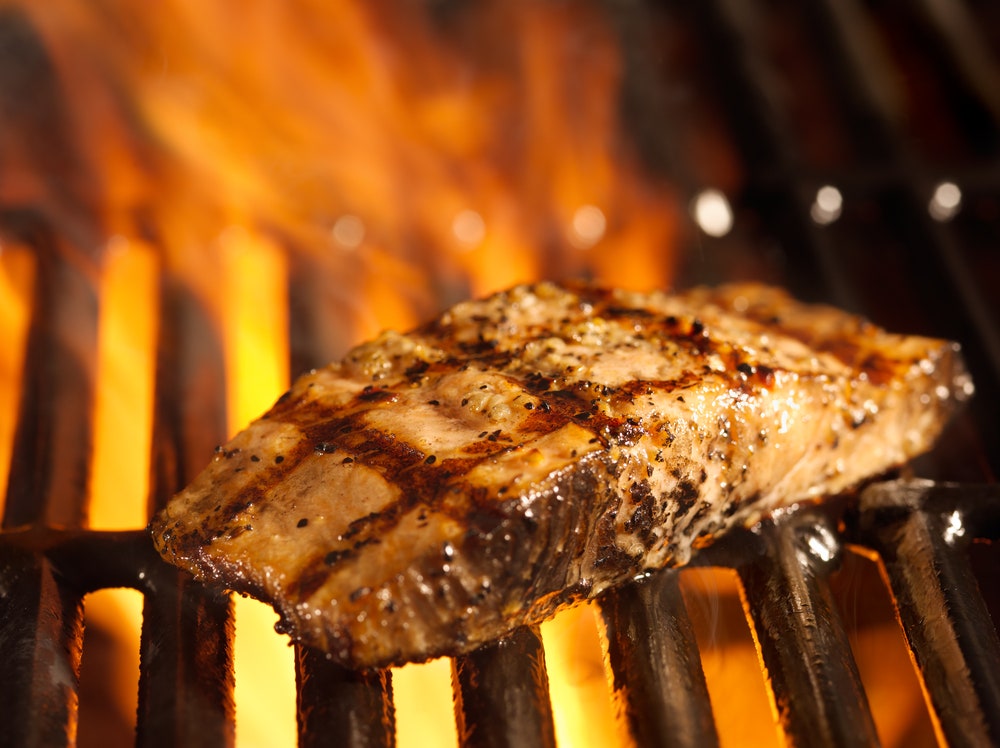
Using a grill pan is a fantastic way to cook a fish fillet, a whole fish, or even a fish steak. Nothing looks more tempting than the grilled seared marks across crispy golden cooked fish.
When grilling fish make sure you have selected a suitable species of fish, fish that have a thick firm flesh is more suitable than some more delicate fish species. Some of the best fish to select from your fishmongers include salmon, tuna, swordfish, and snapper, fish you should avoid grilling include delicate fish like sole, tilapia, or flounder.
Method for using a grill pan to cook fish fillets or whole fish
Remove fish from refrigerator 15 -20 minutes before cooking
Wash the fish fillet, then pat the fish dry with paper towels.
Using a sharp chef’s knife, gently scrape the blade across the fish skin. Any remaining liquid will collect on the blade edge. Remove the moisture from the blade and repeat until there is no more moisture on the knife blade.
Lightly brush both sides of the fish with a thin layer of vegetable oil.
Season both sides of the fish fillet with salt and cracked black pepper.
Place grill pan on high heat until nearly smoking.
Once hot lightly brush the grill pan with a thin layer of vegetable oil.
Wait 10 seconds for the oil to heat, then place the fish fillet skin down diagonally to the grill plates of the pan.
Reduce heat to medium.
Cook for 2 to 4 minutes or until the edges of the fish look a nice golden brown and the edges look crisp. Do not move the fish while it grills. When it is cooked the fish will release from the bottom of the pan. Once the fish has cooked, using a fish spatula, gently lift it from the pan. If you can’t lift the fish cleanly, wait for 30-second intervals and attempt again
Gently flip the fish over, and again place it on the diagonal of the grill plates of the pan.
Cook the fish for another 2 to 4 minutes or until the internal temperature is 63 degrees C. Test with a digital thermometer to ensure the fish is cooked.
Again gently lift fish from the grill pan with your fish spatula and place it on a plate to serve.
Shallow Fried Fish Fillets
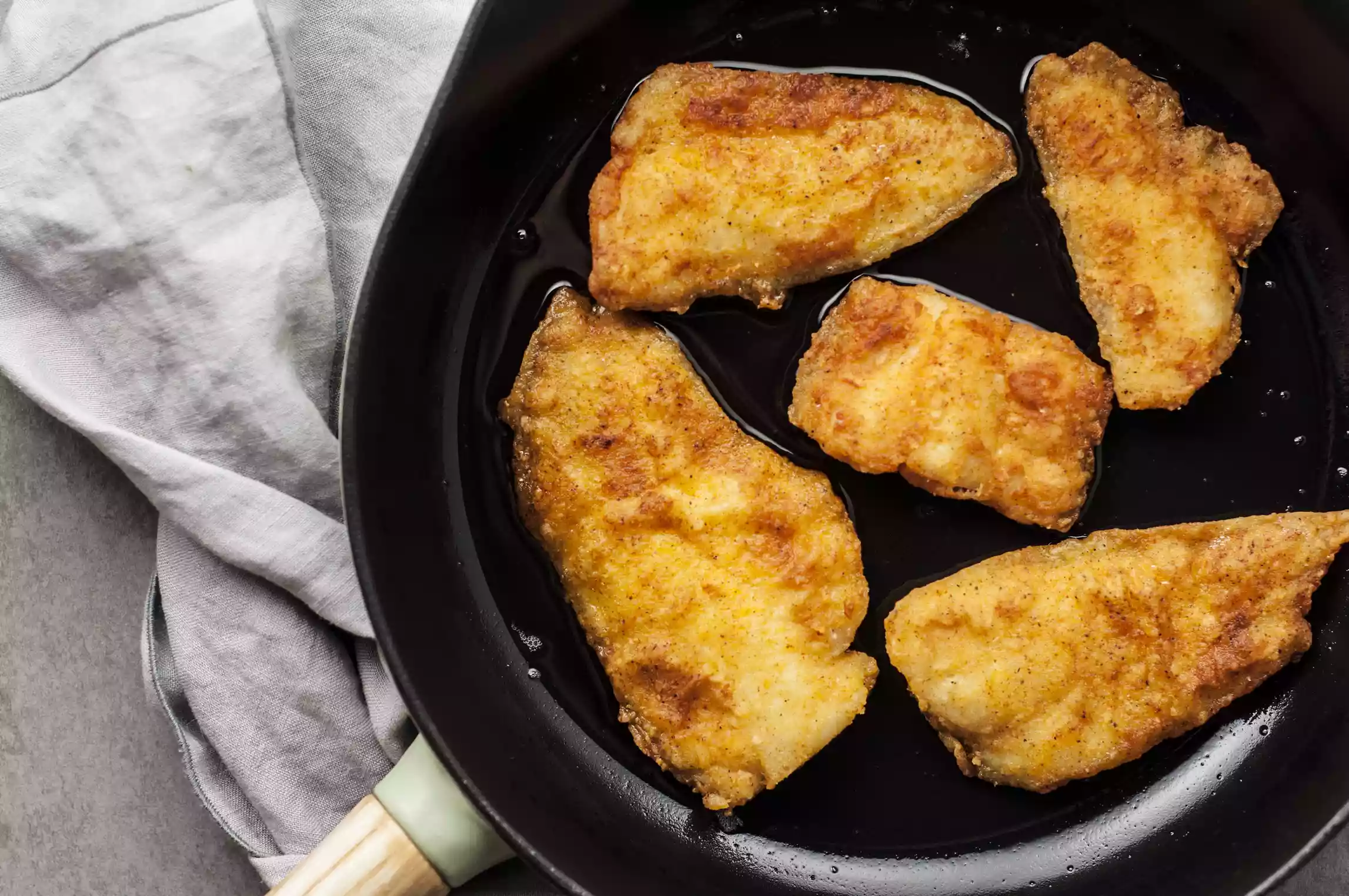
Crispy fried fish is a crowd-pleaser, golden battered or crumbed, nothing is more enjoyable than fried fish. But don’t think you need to cook with tons of oil to achieve a crispy fish and chip shop-style fish dinner. Shallow frying in a stainless steel skillet, using a small amount of oil, can achieve great tasting crispy fish, without the guilt of deep frying with loads of oil.
Snapper, shark, cod, and any firm white flaky fish fillet is suitable for shallow frying, avoid using fish with small bones or oily fatty fish like tuna or salmon.
Method to cook shallow fry fish fillets (250g of fish fillets)
Prepare your fish by patting both sides of the fish dry with a paper towel. Ensure that all the bones have been removed from the fillet before cooking. And season both sides of the fillet with salt and pepper.
In a large bowl combine 140g of self-raising flour with 1 tsp salt, 1tsp of baking soda, ½ tsp of sugar, 1 tsp of instant yeast, and 120 ml of pale ale beer. Mix well and allow to rest for 30 mins.
In another bowl add 100g of tapioca or potato starch.
In a 3 0r 5 ply heavy stainless steel skillet place 1-2cm of vegetable oil. Place skillet on medium heat and heat oil until 175. Celsius. Use a digital thermometer to test temperature. Once the oil is hot adjust heat to maintain 175. Celsius constant heat.
Add fillets to the bowl of starch and lightly coat both sides of the fish, this will help the batter to stick to the fish better.
Once your fish is coated in starch add the fish to the bowl of batter. Coat the entire fish fillet in batter, and lightly lift the fillet by the corner and let the excess batter drip off.
Carefully and slowly, lower the fish fillets into the skillet of hot oil, ensuring the fish lays flat. A good trick so the fish won’t stick to the bottom is to lower half of the fish into the oil and wait until the batter becomes partially cooked then lower the other half. Ensure that the fish is not sticking to the bottom of the pan and cook for 3 minutes.
After 3 minutes, use your fish spatula to carefully lift the fillet and turn it over, use a fork to steady the fish so that to splash yourself with hot oil.
Cook for a further 3 minutes or until golden crispy.
Remove fish from the oil with your fish spatula and place on a wire rack to drain excess oil, then place onto a paper towel to remove any remaining excess oil.
Place on a serving plate, lightly dust with salt, and serve with chips and salad.